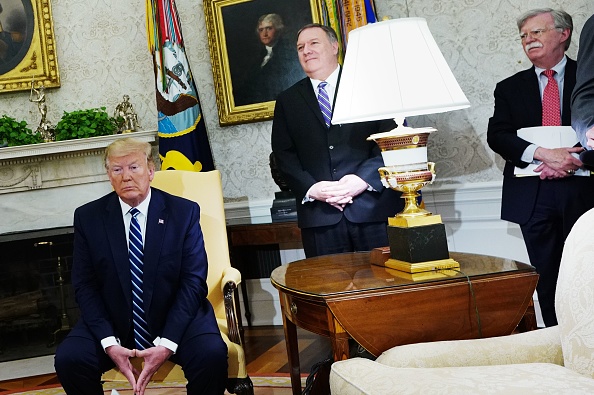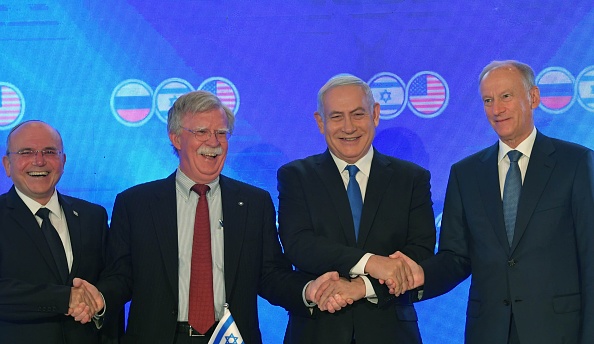Iran’s foreign minister, Mohammad Javad Zarif, said that the move to amass uranium beyond the 300-kilogram cap stated in the deal was a warning to Europe. He gave notice that Iran could also reduce other commitments it signed on if other parties – that is the Europeans – do not start living up to their end of the deal.
Iran – as US president Donald Trump said – is indeed playing with fire. But it doesn’t seem that the regime has a choice in the matter. If they don’t respond to the US “maximum pressure” campaign, their economy will crumble, and when they respond, whether militarily or with decisions to violate the nuclear agreement, they risk to lose the European support, or worse, a war that might lead to their loss and the probable annihilation of their militias in the region.

WHY IS IRAN ESCALATING?
Iran is mainly trying to warn the Europeans. They desperately need Europe to take measures to ease their economic crisis and take a more aggressive diplomatic stance to save the deal and ease sanctions. However, the Iranian regime is also trying to send a message to Washington.
Until recently, Iran’s strategy has been to accept the hits caused by sanctions and diplomatic isolation and wait until the US presidential election in the year 2020, hoping that the Trump administration would leave the scene. Meanwhile, they have been trying to maintain the deal, hoping that the Europeans would begin delivering on promised economic relief.
That doesn’t seem to be working, and Iran seems to have decided to shift strategy. Europe hasn’t delivered. US sanctions have increased, and the Trump administration doesn’t seem to be reconsidering a different approach.
Iran started by testing the US reactions by using its proxy in Yemen – the Houthis – to launch several attacks against Saudi Arabia, then attached the oil tankers in the Strait of Hormuz, and finally downed a US drone. After each and every incident, many observers expected a military response from the Trump administration, especially after the downing of the drone. However, the US still chose not to strike Iran or any of its military facilities that were involved.
For Trump, Iran wanted to drag the US to a military strike, hoping it was not going to be major, but enough to endanger Trump’s presidential candidacy for 2020. The Iranian regime understood that war was not agreeable to the US public opinion and dragging Trump to a military response could have grave consequences in his candidacy.
The Trump administration declined to respond militarily but did respond in other ways. Right after the incident, more sanctions were released, including ones on the supreme leader himself. I addition, the US launched a cyber attack against Iran.
The US targeted an intelligence group that either has ties to or was a part of the Iranian Revolutionary Guards. That group has apparently been connected to the attacks against the oil tankers in the region. According to media reports, the attack was crippling to Iran’s military command and control system. Other reports said that the Iranian missile control systems were also targeted.
Iran failed to drag the US into military action, but it did get a response. Meanwhile, Iran seemed to be the only player that is relying on military tactics that lead to casualties. Consequently, the regime in Tehran is making it more difficult for Europe to remain patient and committed to the nuclear agreement.
The Europeans might get to a point where they lose their patience. All Iran’s efforts to divide the US and its European allies will fail if Iran continues to use this tactic of provocation. The Europeans might eventually decide to join Washington’s “extreme pressure” campaign and take a stance against Iran.
THE WAR IS HAPPENING ELSEWHERE
As Iran is testing the US limits, and warning Europeans, Iran’s regional presence and operations are getting hit in a different way.
On the same day, Iraqi Prime Minister Adel Abdul-Mahdi issued a derivative to the Iraqi Popular Mobilization Forces (PMFs) that they must complete their integration with the Iraqi army by then of July 2019. He said that the PMFs must close their economic offices and steer clear of interests outside the military, sever ties with political leaders, and discard their militia names. Muqtada Al-Sadr was the first to accept the premier’s call.
This decision came after an attack on Saudi oil infrastructure in May was suspected to have originated from Iraq. In addition, there have been concerns that Kataeb Hezbollah was involved in storming the Bahraini embassy in Baghdad on June 27.
Although it is too early to see if this move is a serious step by Abdel-Mahdi, and if the rest of the PMFs are going to support this decision, the statement itself is loaded with messages. Even if Iran’s supported militias in Iraq are not going to dismantle and join the Iraqi army, it will become more difficult for Iran to use Iraq as a base to attack the US and Gulf state’s interests in the region.
That same night, first of July, Israel targeted ten Iranian and Hezbollah facilities in Syria, killing sixteen of their personnel. This was one of the largest Israeli attacks in recent years. The timing is also interesting as it took place a few days after the summit in Jerusalem of national security advisors from the US, Russia, and Israel. Reports about the distribution of the sites that were attacked show that Israel was after Iran’s infrastructure in Syria, which is the logistical chain that supplies advanced weapons to Hezbollah, and linking Iran to Lebanon via Syria.

Russia allowed Israel to destroy a major part of the Iranian infrastructure in Syria, and Hezbollah did not respond, leaving the Syrian army to their weak attempts. If anything, this means that even if Iran wanted to respond to the US sanctions, it can only do very calibrated and feeble attacks, because Iran cannot afford a war with Israel or with the US. These attacks can’t change much in the status co, won’t stop the US from increasing pressure on Iran, and will only make Iran look desperate.
But more importantly, Iran will lose the European support for the nuclear deal and will push them further into isolation. Iran’s choices are limited, and the regime’s future doesn’t look so bright.







